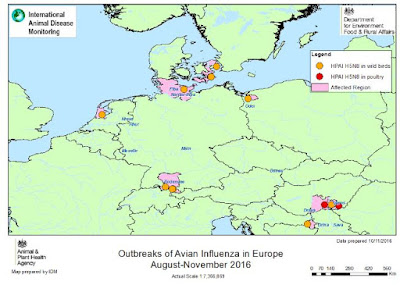#11,897
An indication of how quickly events are changing on the ground in Europe's battle against avian H5N8, for the third time in less than a week the UK's DEFRA (Department for Environment, Food & Rural Affairs) has published an updated assessment.
Today's assessment takes special note of what appears to be a higher mortality rate among wild birds than we've previously seen with H5N8, and its similarities to the the spread of H5N1 in the middle of the last decade. They write:
The pattern of this year’s reports is different to previous years (2014/15) when this virus was first detected in Europe. The mortality events and the species of wild waterfowl affected might indicate possible changes in virus pathogenicity and/or changes in host specificity.
Viruses continually evolve, and in Monday's FAO On HPAI H5's 4th Intercontinental Wave, we saw the following discussion of H5N8's detection earlier this summer in Russia:
The precise origin of the Tyva 2016 H5N8 virus remains unknown although available evidence suggests it was derived from earlier H5N8 viruses detected in Eastern China (WHO 2016). The virus is readily distinguishable from strains of H5N8 virus found in Europe and North America in 2014-15.
The other concern, which hasn't seen much discussion this week, is that HPAI H5N8 has shown a remarkable propensity for mixing with other viruses and churning out viable reassortants.
Last month, in Migratory Birds & The Spread Of Highly Pathogenic Avian Flu, we looked at a study which described the H5N8 (clade 2.3.4.4) virus as:
. . . . remarkably promiscuous, creating reassortants with multiple neuraminidase subtypes. Improving our understanding of the circumpolar circulation of avian influenza viruses in migratory waterfowl will help to provide early warning of threats from avian influenza to poultry, and potentially human, health.All of which gives this year's introduction and spread of H5N8 a certain degree of uncertainty. Past performance - particularly with flu viruses - is no guarantee of future results.
This from DEFRA.
Updated Outbreak Assessment number 2
Highly Pathogenic Avian Influenza H5N8 in Europe
11th November 2016 Ref: VITT/1200 Avian Influenza in Europe
Disease Report
Currently eight countries in Europe (Austria , Croatia, Denmark, Germany, Hungary, Netherlands, Poland and Switzerland) have reported numerous detections of H5N8 HPAI, between 3rd and 11th November. These outbreaks have effected various wild bird species including Tufted Ducks (Aythya fuligula), Coots (Fulica atra), Common Pochard (Aythya ferina), gull species, curlews, wild geese and wild swans. A number of these mortalities have been associated with wider wild bird mortality events.
Situation Assessment
These findings suggest there are at least two potential migration routes for wild birds which may be infected with this virus strain. Firstly, Poland, Northern Germany, Denmark and Netherlands on a Northern Baltic route and Croatia, Hungary, Southern Germany, Switzerland and Austria along a central European route to include the Danube and Mediterranean route Migratory birds are currently moving from the Baltic into NW Europe and the UK.
The pattern of this year’s reports is different to previous years (2014/15) when this virus was first detected in Europe. The mortality events and the species of wild waterfowl affected might indicate possible changes in virus pathogenicity and/or changes in host specificity. However significant uncertainties exist at this early stage and other wild waterfowl species may be infected without mortality.
The number, rate, mortality and geographic spread of these new cases in wild birds is significant and shares some features with the initial spread of H5N1 HPAI of the goose/Guandong lineage of viruses to Europe in late 2005/early 2006. . As a result, the risk to the UK of the incursion of a wild bird infected with H5N8 HPAI in the coming weeks has significantly increased to medium from low. The risk to poultry farms will depend on their level of biosecurity, but generally we consider at the present time it remains at low but heightened.
Conclusion
We would like to remind all poultry keepers to maintain high standards of biosecurity, remain vigilant and report any suspect clinical signs promptly. Poultry keepers should also remind themselves of the mild clinical signs of LPAI infection and be aware of any changes in egg production, feed and water intake or rise in mortality above baseline. Whilst clinical signs in chickens and turkeys with HPAI can be very marked with often rapid onset they may initially manifest as reductions in feed or water intake (>5%). Furthermore clinical signs in domestic waterfowl for this current strain of virus are less certain and may present as a wide spectrum with variable mortality. Any significant wild bird die-offs can be reported via the Defra helpline at defra.helpline@defra.gsi.gov.uk
We will continue to report on the situation
